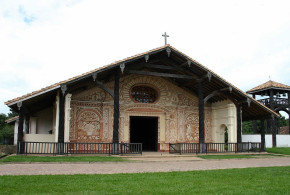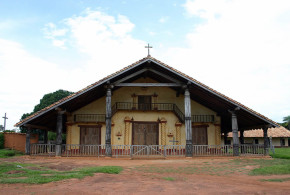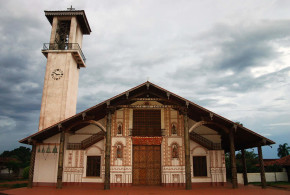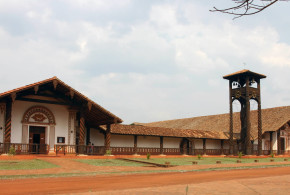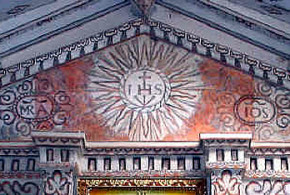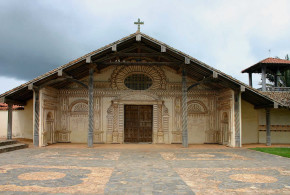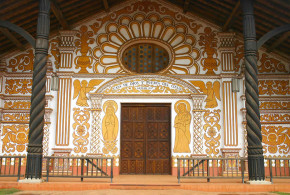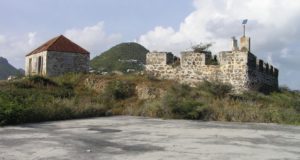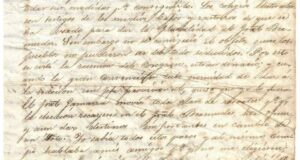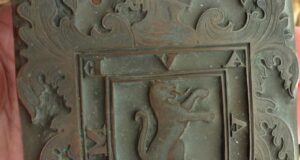Written by Marco Ramerini, 2005-2021 (English translation: 2023) General index THE FAILED EXPEDITIONS TO ALGIERS 3 FIRST EXPEDITION TO ALGIERS 4 SECOND EXPEDITION TO ALGIERS 9 THE MOLUCCAS 10 THE CONQUIST OF TERNATE AND THE MOLUCCAS 10 THE EXPEDITION TO MALACCA 15 THE PHILIPPINES 18 THE YUCATAN 20 FIRST TERM OF GOVERNOR 20 SECOND TERM OF GOVERNOR 22 THE WIDOW ...
Read More »America
Esteban de Alcázar, a soldier in the service of the king of Spain in Europe, the Philippines and the Moluccas
Written by Marco Ramerini – 2021 (English translation: 2023) General Index AROUND EUROPE p. 3 ARAGON, ITALY, FRANCE p. 3 FLANDERS, FRISIA, GELDRIA… p. 4 THE RETURN TO SPAIN p. 7 IN THE PHILIPPINES AND THE MOLUCCAS p. 10 THE CONQUEST OF TERNATE p. 10 THE FIRST BATTLE OF PLAYA HONDA p. 11 PERMANENCE IN TERNATE p. 11 THE WEDDING ...
Read More »The main fort of Fernando de Noronha: Fortress of Nossa Senhora Dos Remédios
Written by Marco Ramerini. English text revision by Dietrich Köster. The fortress of Nossa Senhora dos Remédios is the most important fortification of the entire defensive system built on the island of Fernando de Noronha (Brazil) by the Portuguese in the eighteenth century and is located on a hill between the Bay of Santo António and the Praia do Cachorro. ...
Read More »San Rafael de Velasco mission, Chiquitania, Bolivia
Written by Geoffrey A. P. Groesbeck San Rafael de Velasco, the second oldest mission settlement in the Chiquitania, was established in 1696 by the Jesuit missionaries Juan Bautista Zea and Francisco Hervás (each of whom later co-founded two other missions). It was settled largely as what was then anticipated as an eventual way stop along the road to other Jesuit ...
Read More »Santa Ana de Velasco mission, Chiquitania, Bolivia
Written by Geoffrey A. P. Groesbeck Santa Ana de Velasco, founded in 1755, holds the distinction of being the only Chiquitos mission founded by one individual, the Jesuit missionary Julián Nogler. It is also is the only settlement that has its original church almost wholly intact (restoration on it is ongoing), which also happens to be the only church built ...
Read More »San José de Chiquitos mission, Chiquitania, Bolivia
Written by Geoffrey A. P. Groesbeck San José de Chiquitos, the third-oldest Jesuit mission in the Chiquitania and one of the prettiest, was founded in 1697 by Felipe Suárez (who later co-founded San Miguel de Velasco to the north) and Dionisio Avila. Relocated in 1706, it was its new location that made it the most important town in the region ...
Read More »San Ignacio de Velasco mission, Chiquitania, Bolivia
Written by Geoffrey A. P. Groesbeck San Ignacio de Velasco was founded in 1748, primarily for the benefit of the local Ugaraño peoples, by Jesuits Miguel Areijer and Diego Contreras. It was settled in part by the inhabitants of a former reducción, San Ignacio de Zamucos, which was destroyed three years earlier. One of the few missions that was not ...
Read More »Concepción mission, Chiquitania, Bolivia
Written by Geoffrey A. P. Groesbeck Concepción was first established as the mission of La Inmaculada Concepción in 1699, although this settlement lasted only until 1704. It was re-established in 1709 (a date that some historians incorrectly claim as its founding), and incorporated the nearby ephemeral mission of San Ignacio de Boococas in 1712. Concepción was established by Jesuit missionaries ...
Read More »San Javier mission, Chiquitania, Bolivia
Written by Geoffrey A. P. Groesbeck San Javier (originally San Francisco Xavier de los Piñocas), the earliest permanent Jesuit mission in the Chiquitania, was founded by the missionaries José de Arce and Antonio de Rivas on 31 December 1691. It was rebuilt three times (in 1696, 1698, and 1705-6) before assuming its present form in 1708. Today it is a ...
Read More »The Long Silence: The Jesuit Missions of Chiquitos after the Extrañamiento
Written by Geoffrey A P Groesbeck Introduction There is much still to discover regarding the early history of the Jesuit missions (reducciones1) of Chiquitos2 (1691-1767). By now it has been reasonably well documented3, albeit in greater detail in Spanish and German than in English. Over the last three decades, scholarly research on these missions’ individual and collective artistic, musical, and ...
Read More »A Brief History of the Jesuit Missions of Chiquitos
Written by Geoffrey A P Groesbeck Introduction It is a simple fact that no comprehensive history of the Jesuit missions of Chiquitos1 exists in English.2 There are numerous accounts in Spanish, most of which rely primarily upon two secondary sources dating from the nineteenth century: D’Orbigny’s recollections of his travels in the region between 1831 and 18333, and René-Moreno’s numerous ...
Read More »The forts of the Saint-Martin island: Fort Amsterdam and Fort Louis
Written by Marco Ramerini. The island of Saint-Martin (Sint Maarten) is an island of the Lesser Antilles in the Caribbean. The island is located between the islands of Anguilla and Saint-Barthélemy and has the distinction of being divided between France and the Netherlands. This division dates back to the treaty signed by the two countries in 1648 (Treaty of Concordia) ...
Read More »The Forts of Fernando de Noronha
Written by Marco Ramerini. English text revision by Dietrich Köster. Fernando de Noronha was discovered by the Florentine Amerigo Vespucci in 1503. In 1504 the Crown granted the archipelago as a “capitania hereditária” to a Portuguese lord, Fernão de Noronha, from whom it takes its name. The archipelago was occupied by two other European nations (Dutch and French) during the ...
Read More »Letter by General Luis Jose Orbegoso y Moncada, 1834
Written by Randy Shaw. General Luis José de Orbegoso y Moncada, scion of an aristocratic criollo family from Trujillo, in northern Peru, was Provisional President of the country between 1833 and 1834, and was named in 1837-1838 President of the short-lived Republic of North Peru, set up by the Peru-Bolivia Confederacy after the invasion of the country by Bolivian strongman ...
Read More »Heraldic Coat of Arms encased in wood that belonged to Pedro Pizarro
Written by Randy Shaw Several years ago General Jose Ramon Pizarro who was many times over the great grandson of the Spanish Chronicler and Conquistador Pedro Pizarro passed away in Lima Peru his widow contacted a mutual friend to discuss an item that had descended down through the family of Pedro Pizarro. So on my next trip to Lima my ...
Read More »South America. List of Dutch forts and colonial possessions
Written by Marco Ramerini. English text revision by Dietrich Köster. COLOMBIA Santa Marta: Netherlands: 16 Feb. 1630 – 21/22 Feb. 1630 abandoned to Spain Goslinga “The Dutch in the Caribbean and on the Wild Coast 1580 – 1680” VENEZUELA: Punta de Araya: Goslinga “The Dutch in the Caribbean and on the Wild Coast 1580 – 1680” Isla Tortuga: Goslinga “The Dutch in the ...
Read More »North America. List of Dutch colonial forts and possessions
Written by Marco Ramerini USA CONNECTICUT: Fort Goed Hope (Hartford): Fort Goed Hope, Fort Huis ter Hope DELAWARE: Prinseneiland, Moordenaarseiland (Murderer’s Island, Prince’s Island): Fort Wilhelmus Fort Casimir (Newcastle): Nieuw Amstel, Fort Nieuwer Amstel, Fort Drie-eenheid Altona, Altena (Wilmington): Fort Christina, Fort Altena Blommaerts Kil, Horekil, Whorekill, Hoerenkill: Compagniesfort, Compagniesfort Whorekill Swaenendael (Lewes): MAINE: Pentagouet: Netherlands: Aug. 1674 – Sep. ...
Read More »Central America. List of Dutch colonial forts and possessions
Written by Marco Ramerini. English text revision by Dietrich Köster. PUERTO RICO San Juan de Puerto Rico: Netherlands: Sep. 1625 – 2 Nov. 1625 abandoned to Spain The Dutch occupied only the town and the fort of Canuela at the bay entrance. The fort of Canuela is retaken by the Spanish after three weeks. The Morro Fortress remains in the ...
Read More »America. List of Portuguese colonial forts and possessions
Written by Marco Ramerini. English text revision by Dietrich Köster. UNDER COSTRUCTION… BRAZIL: Cabo Frio: feitoria Fernando de Noronha: Portuguese to The Netherlands Portuguese: – Oct. 1734 to France (Oct 1734 – 1737) Portuguese: 1737 – Bahia: Portuguese: -10 May 1624 to The Netherlands (10 May 1624 – 30 Apr. 1625) 30 Apr. 1625 – Olinda: Portuguese: -16 Feb. 1630 to ...
Read More »America. Portuguese Colonial Remains 16th-18th centuries
Written by Marco Ramerini. English text revision by Dietrich Köster. If you know something on colonial remains or if you have photos of such remains – they may be anywhere in the world -, send them to me. I’ll be happy to publish them on this website. Thank you. Marco. My e-mail is on the home page. PORTUGUESE COLONIAL REMAINS ...
Read More » Colonial Voyage The website dedicated to the Colonial History
Colonial Voyage The website dedicated to the Colonial History




